Making a large island
- Fun fact: The underlying concept of this programming problem is extensively used in image processing applications and computer vision
- Specifically, these applications use morphological operations which can include expanding the area of a unique color (akin to changing a 0 to a 1 in the problem) and then determining the size of the largest connected component (or the largest island)
- This can help in identifying and tracking objects or features in an image or video stream
- This technique can be used in a variety of industries such as surveillance systems, autonomous vehicle systems, medical imaging processing, and more!
Given an n x n binary matrix grid, it is allowed to change at most one 0 to 1. A group of connected 1s forms an island, where two 1s are connected if they share one of their sides.
Return the size of the largest island in the grid after applying this operation.
Examples:
Input: grid = [[1,0],[0,1]]
Output: 3
Explanation: We change any one 0 to 1 and connect two 1s, then we get an island with maximum area = 3.
Input: grid = [[1,1],[1,1]]
Output: 4
Explanation: The largest island already exists with size 4.
Input: grid = [[1,1],[1,0]]
Constraints
- 1 <= n <= 500
- 0 <= grid[i][j] <= 1
Hints
- "Label each island with a unique index using DFS and store its size in a hashmap {island_id: size}. For every 0 in the grid, check its adjacent 1s (up, down, left, right). The answer is the maximum size of any modified island. "
- "Instead of running DFS/BFS for every possible 0 flip, we precompute all islands first and store their sizes. Each 0 can be flipped into 1, and we check how many distinct islands it connects to. The goal is to find a 0 that maximizes the total merged island size."
Company Tags
Editorial
Intuition:
In the given grid, there are different sizes of connected 1s already present. The problem allows converting a single cell containing 0 to 1, and the goal is to form the largest island.
One way to solve this is by using the brute force approach by finding the largest island formed in the grid by successively converting each cell containing 0 to 1. The largest island found in all such cases will be the island with the most 1s which can be returned as our answer.
Understanding:
As each time, a cell having 0 is turned into 1, it forms an edge with its four neighbors(islands), if existing. This indicates that the graph is dynamic in nature. Now, adding an edge in a dynamic graph can be easily achieved using the Disjoint Set data structure.Using the Union By Size method in the Disjoint Set data structure, not only the efficient addition of edges can be done but also, the size of islands after merging can be found.
How to store cells as nodes in the Disjoint Set?
The cells can be numbered sequentially as shown in the following figure: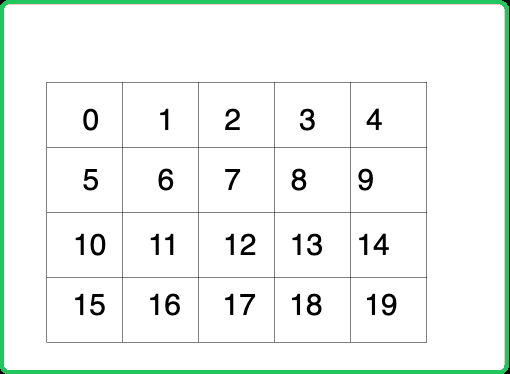
Thus, a number can be assigned to a cell having coordinates (i, j) in the following way:
Node number = i*n + j, where n is the number of columns in the grid
Edge Cases:
Consider the following graph:
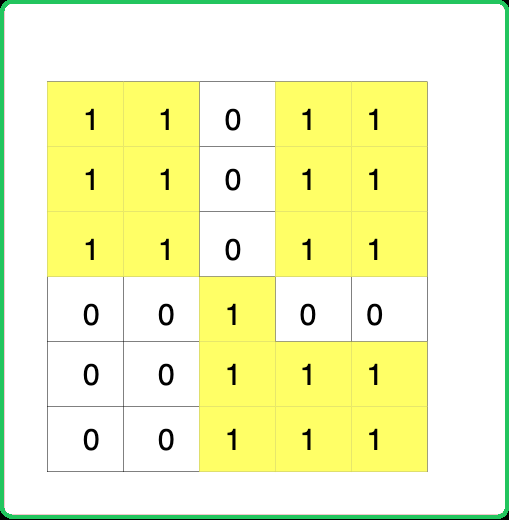
In the given grid, all the cells with 0 will be converted one by one to check for the largest island. Considering 0-based indexing, the cell (3,3) will be converted to 1, and while checking:
- Left Island: The size of island will be incremented by 7.
- Top Island: The size of island will be incremented by 6.
- Right Island: No change in the size of the island as there is no island present on the right.
- Bottom Island: Again the size of the island will be incremented by 7.
But the island of size 7 should have been considered only once while finding the size of the large island. This case can be avoided by storing the ultimate parents for the neighboring islands in a set data structure. This will ensure that one island will never be considered more than once in the size of large island.
What if all the cells are 1 in the grid?
In such case, only one island will be formed which will be the largest for which the size of the ultimate parent of the island can be returned as the answer.Approach:
- Create a Disjoint Set data structure to manage connected components (islands) in the grid. Each cell is treated as a separate component initially.
- Traverse through the grid to identify initial islands (connected 1s) and perform union operations to merge adjacent land cells into the same component using the union by size method.
- Traverse the grid again to consider each 0 cell, and determine the potential island size if this 0 is changed to 1.
- For each 0 cell, check all its neighboring cells to find unique components (using ultimate parents) and calculate the combined size of these components.
- Keep track of the maximum island size encountered during the above calculations. Additionally, handle edge cases where no 0 cells are present in the grid by checking the sizes of existing islands.
- Return the size of the largest possible island after changing at most one 0 to 1.
Dry Run:
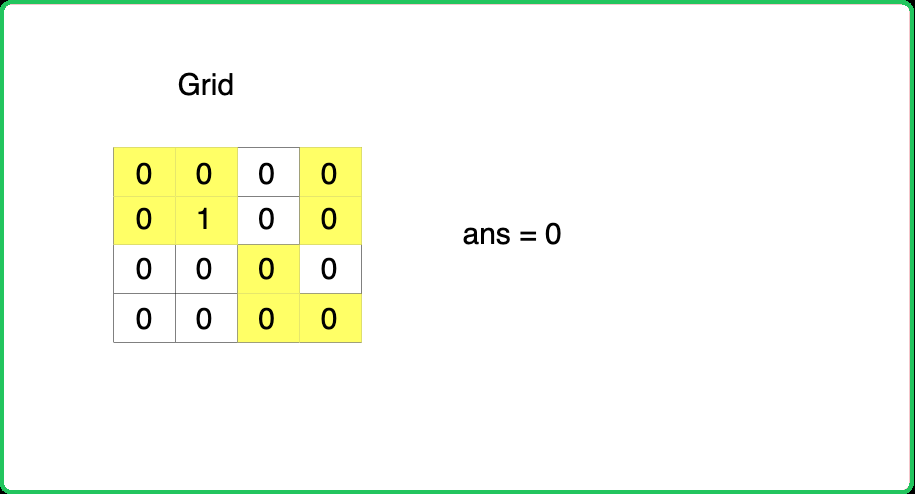
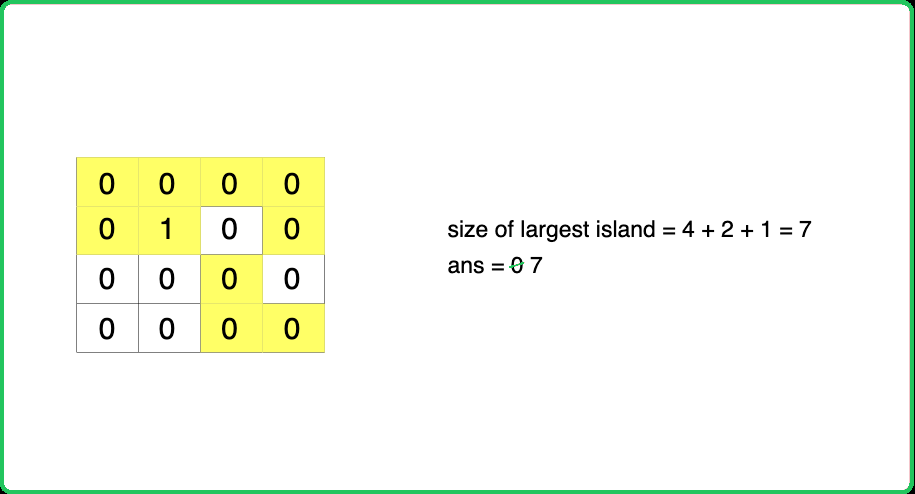
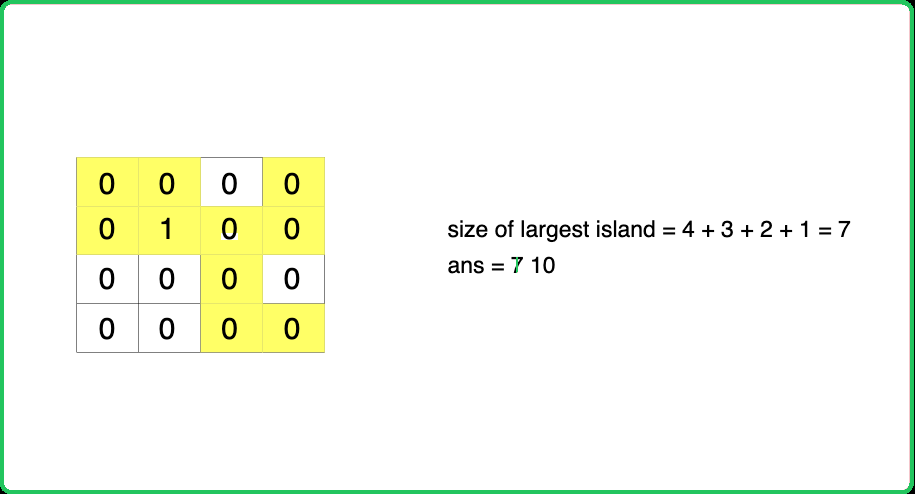
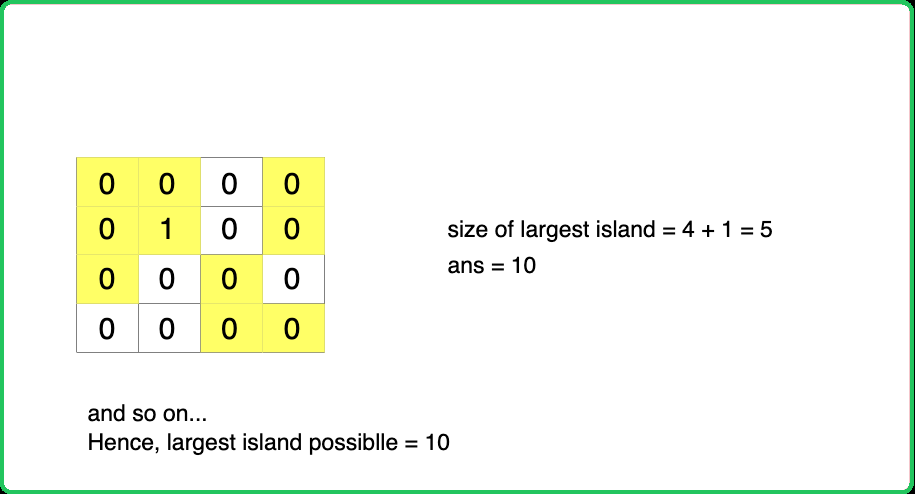




Solution:
#include <bits/stdc++.h>
using namespace std;
class DisjointSet {
public:
/* To store the ranks, parents and
sizes of different set of vertices */
vector<int> rank, parent, size;
// Constructor
DisjointSet(int n) {
rank.resize(n + 1, 0);
parent.resize(n + 1);
size.resize(n + 1);
for (int i = 0; i <= n; i++) {
parent[i] = i;
size[i] = 1;
}
}
// Function to find ultimate parent
int findUPar(int node) {
if (node == parent[node])
return node;
return parent[node] = findUPar(parent[node]);
}
// Function to implement union by rank
void unionByRank(int u, int v) {
int ulp_u = findUPar(u);
int ulp_v = findUPar(v);
if (ulp_u == ulp_v) return;
if (rank[ulp_u] < rank[ulp_v]) {
parent[ulp_u] = ulp_v;
}
else if (rank[ulp_v] < rank[ulp_u]) {
parent[ulp_v] = ulp_u;
}
else {
parent[ulp_v] = ulp_u;
rank[ulp_u]++;
}
}
// Function to implement union by size
void unionBySize(int u, int v) {
int ulp_u = findUPar(u);
int ulp_v = findUPar(v);
if (ulp_u == ulp_v) return;
if (size[ulp_u] < size[ulp_v]) {
parent[ulp_u] = ulp_v;
size[ulp_v] += size[ulp_u];
}
else {
parent[ulp_v] = ulp_u;
size[ulp_u] += size[ulp_v];
}
}
};
// Solution class
class Solution{
private:
// DelRow and delCol for neighbors
vector<int> delRow = {-1, 0, 1, 0};
vector<int> delCol = {0, 1, 0, -1};
/* Helper Function to check if a
pixel is within boundaries */
bool isValid(int &i, int &j, int &n) {
// Return false if pixel is invalid
if(i < 0 || i >= n) return false;
if(j < 0 || j >= n) return false;
// Return true if pixel is valid
return true;
}
/* Function to add initial islands to
the disjoint set data structure */
void addInitialIslands(vector<vector<int>> grid,
DisjointSet &ds, int n) {
// Traverse all the cells in the grid
for (int row = 0; row < n ; row++) {
for (int col = 0; col < n ; col++) {
// If the cell is not land, skip
if (grid[row][col] == 0) continue;
// Traverse on all the neighbors
for (int ind = 0; ind < 4; ind++) {
// Get the coordinates of neighbor
int newRow = row + delRow[ind];
int newCol = col + delCol[ind];
// If the cell is valid and a land cell
if (isValid(newRow, newCol, n) &&
grid[newRow][newCol] == 1) {
// Get the number for node
int nodeNo = row * n + col;
// Get the number for neighbor
int adjNodeNo = newRow * n + newCol;
/* Take union of both nodes as they
are part of the same island */
ds.unionBySize(nodeNo, adjNodeNo);
}
}
}
}
}
public:
// Function to get the size of the largest island
int largestIsland(vector<vector<int>>& grid) {
// Dimensions of grid
int n = grid.size();
// Disjoint Set data structure
DisjointSet ds(n*n);
/* Function call to add initial
islands in the disjoint set */
addInitialIslands(grid, ds, n);
// To store the answer
int ans = 0;
// Traverse on the grid
for (int row = 0; row < n; row++) {
for (int col = 0; col < n; col++) {
// If the cell is a land cell, skip
if (grid[row][col] == 1) continue;
/* Set to store the ultimate parents
of neighboring islands */
set<int> components;
//Traverse on all its neighbors
for (int ind = 0; ind < 4; ind++) {
// Coodinates of neigboring cell
int newRow = row + delRow[ind];
int newCol = col + delCol[ind];
if (isValid(newRow, newCol, n) &&
grid[newRow][newCol] == 1) {
/* Perform union and store
ultimate parent in the set */
int nodeNumber = newRow * n + newCol;
components.insert(ds.findUPar(nodeNumber));
}
}
// To store the size of current largest island
int sizeTotal = 0;
// Iterate on all the neighborinh ultimate parents
for (auto it : components) {
// Update the size
sizeTotal += ds.size[it];
}
// Store the maximum size of island
ans = max(ans, sizeTotal + 1);
}
}
// Edge case
for (int cellNo = 0; cellNo < n * n; cellNo++) {
// Keep the answer updated
ans = max(ans, ds.size[ds.findUPar(cellNo)]);
}
// Return the answer
return ans;
}
};
int main() {
vector<vector<int>> grid = {
{1,0},
{0,1}
};
// Creating instance of Solution class
Solution sol;
/* Function call to get the
size of the largest island */
int ans = sol.largestIsland(grid);
// Output
cout << "The size of the largest island is: " << ans;
return 0;
}import java.util.*;
class DisjointSet {
/* To store the ranks, parents and
sizes of different set of vertices */
int[] rank, parent, size;
// Constructor
DisjointSet(int n) {
rank = new int[n + 1];
parent = new int[n + 1];
size = new int[n + 1];
for (int i = 0; i <= n; i++) {
parent[i] = i;
size[i] = 1;
}
}
// Function to find ultimate parent
int findUPar(int node) {
if (node == parent[node])
return node;
return parent[node] = findUPar(parent[node]);
}
// Function to implement union by rank
void unionByRank(int u, int v) {
int ulp_u = findUPar(u);
int ulp_v = findUPar(v);
if (ulp_u == ulp_v) return;
if (rank[ulp_u] < rank[ulp_v]) {
parent[ulp_u] = ulp_v;
}
else if (rank[ulp_v] < rank[ulp_u]) {
parent[ulp_v] = ulp_u;
}
else {
parent[ulp_v] = ulp_u;
rank[ulp_u]++;
}
}
// Function to implement union by size
void unionBySize(int u, int v) {
int ulp_u = findUPar(u);
int ulp_v = findUPar(v);
if (ulp_u == ulp_v) return;
if (size[ulp_u] < size[ulp_v]) {
parent[ulp_u] = ulp_v;
size[ulp_v] += size[ulp_u];
}
else {
parent[ulp_v] = ulp_u;
size[ulp_u] += size[ulp_v];
}
}
}
// Solution class
class Solution {
// DelRow and delCol for neighbors
private int[] delRow = {-1, 0, 1, 0};
private int[] delCol = {0, 1, 0, -1};
/* Helper function to check
if a pixel is within boundaries */
private boolean isValid(int i, int j, int n) {
// Return false if pixel is invalid
if (i < 0 || i >= n) return false;
if (j < 0 || j >= n) return false;
// Return true if pixel is valid
return true;
}
/* Function to add initial islands to
the disjoint set data structure */
private void addInitialIslands(int[][] grid,
DisjointSet ds, int n) {
// Traverse all the cells in the grid
for (int row = 0; row < n; row++) {
for (int col = 0; col < n; col++) {
// If the cell is not land, skip
if (grid[row][col] == 0) continue;
// Traverse on all the neighbors
for (int ind = 0; ind < 4; ind++) {
// Get the coordinates of neighbor
int newRow = row + delRow[ind];
int newCol = col + delCol[ind];
// If the cell is valid and a land cell
if (isValid(newRow, newCol, n) &&
grid[newRow][newCol] == 1) {
// Get the number for node
int nodeNo = row * n + col;
// Get the number for neighbor
int adjNodeNo = newRow * n + newCol;
/* Take union of both nodes as they
are part of the same island */
ds.unionBySize(nodeNo, adjNodeNo);
}
}
}
}
}
// Function to get the size of the largest island
public int largestIsland(int[][] grid) {
// Dimensions of grid
int n = grid.length;
// Disjoint set data structure
DisjointSet ds = new DisjointSet(n * n);
/* Function call to add initial
islands in the disjoint set */
addInitialIslands(grid, ds, n);
// To store the answer
int ans = 0;
// Traverse on the grid
for (int row = 0; row < n; row++) {
for (int col = 0; col < n; col++) {
// If the cell is a land cell, skip
if (grid[row][col] == 1) continue;
/* Set to store the ultimate
parents of neighboring islands */
Set<Integer> components = new HashSet<>();
// Traverse on all its neighbors
for (int ind = 0; ind < 4; ind++) {
// Coordinates of neighboring cell
int newRow = row + delRow[ind];
int newCol = col + delCol[ind];
if (isValid(newRow, newCol, n) &&
grid[newRow][newCol] == 1) {
/* Perform union and store
ultimate parent in the set */
int nodeNumber = newRow * n + newCol;
components.add(ds.findUPar(nodeNumber));
}
}
// To store the size of current largest island
int sizeTotal = 0;
// Iterate on all the neighboring ultimate parents
for (int parent : components) {
// Update the size
sizeTotal += ds.size[ds.findUPar(parent)];
}
// Store the maximum size of island
ans = Math.max(ans, sizeTotal + 1);
}
}
// Edge case
for (int cellNo = 0; cellNo < n * n; cellNo++) {
// Keep the answer updated
ans = Math.max(ans, ds.size[ds.findUPar(cellNo)]);
}
// Return the answer
return ans;
}
public static void main(String[] args) {
int[][] grid = {
{1, 0},
{0, 1}
};
// Creating instance of Solution class
Solution sol = new Solution();
/* Function call to get the
size of the largest island */
int ans = sol.largestIsland(grid);
// Output
System.out.println("The size of the largest island is: " + ans);
}
}
class DisjointSet:
# To store the ranks, parents and
# sizes of different set of vertices
def __init__(self, n):
self.rank = [0] * (n + 1)
self.parent = [i for i in range(n + 1)]
self.size = [1] * (n + 1)
# Function to find ultimate parent
def findUPar(self, node):
if node == self.parent[node]:
return node
self.parent[node] = self.findUPar(self.parent[node])
return self.parent[node]
# Function to implement union by rank
def unionByRank(self, u, v):
ulp_u = self.findUPar(u)
ulp_v = self.findUPar(v)
if ulp_u == ulp_v:
return
if self.rank[ulp_u] < self.rank[ulp_v]:
self.parent[ulp_u] = ulp_v
elif self.rank[ulp_v] < self.rank[ulp_u]:
self.parent[ulp_v] = ulp_u
else:
self.parent[ulp_v] = ulp_u
self.rank[ulp_u] += 1
# Function to implement union by size
def unionBySize(self, u, v):
ulp_u = self.findUPar(u)
ulp_v = self.findUPar(v)
if ulp_u == ulp_v:
return
if self.size[ulp_u] < self.size[ulp_v]:
self.parent[ulp_u] = ulp_v
self.size[ulp_v] += self.size[ulp_u]
else:
self.parent[ulp_v] = ulp_u
self.size[ulp_u] += self.size[ulp_v]
def getSize(self, node):
return self.size[self.findUPar(node)]
# Solution class
class Solution:
# DelRow and delCol for neighbors
delRow = [-1, 0, 1, 0]
delCol = [0, 1, 0, -1]
# Helper function to check if a
# pixel is within boundaries
def isValid(self, i, j, n):
# Return false if pixel is invalid
if i < 0 or i >= n:
return False
if j < 0 or j >= n:
return False
# Return true if pixel is valid
return True
# Function to add initial islands to the
# disjoint set data structure
def addInitialIslands(self, grid, ds, n):
# Traverse all the cells in the grid
for row in range(n):
for col in range(n):
# If the cell is not land, skip
if grid[row][col] == 0:
continue
# Traverse on all the neighbors
for ind in range(4):
# Get the coordinates of neighbor
newRow = row + self.delRow[ind]
newCol = col + self.delCol[ind]
# If the cell is valid and a land cell
if (self.isValid(newRow, newCol, n) and
grid[newRow][newCol] == 1):
# Get the number for node
nodeNo = row * n + col
# Get the number for neighbor
adjNodeNo = newRow * n + newCol
# Take union of both nodes as
# they are part of the same island
ds.unionBySize(nodeNo, adjNodeNo)
# Function to get the size of the largest island
def largestIsland(self, grid):
# Dimensions of grid
n = len(grid)
# Disjoint set data structure
ds = DisjointSet(n * n)
# Function call to add initial
# islands in the disjoint set
self.addInitialIslands(grid, ds, n)
# To store the answer
ans = 0
# Traverse on the grid
for row in range(n):
for col in range(n):
# If the cell is a land cell, skip
if grid[row][col] == 1:
continue
# Set to store the ultimate
# parents of neighboring islands
components = set()
# Traverse on all its neighbors
for ind in range(4):
# Coordinates of neighboring cell
newRow = row + self.delRow[ind]
newCol = col + self.delCol[ind]
if (self.isValid(newRow, newCol, n) and
grid[newRow][newCol] == 1):
# Perform union and store
# ultimate parent in the set
nodeNumber = newRow * n + newCol
components.add(ds.findUPar(nodeNumber))
# To store the size of current largest island
sizeTotal = 0
# Iterate on all the neighboring ultimate parents
for parent in components:
# Update the size
sizeTotal += ds.getSize(parent)
# Store the maximum size of island
ans = max(ans, sizeTotal + 1)
# Edge case
for cellNo in range(n * n):
# Keep the answer updated
ans = max(ans, ds.getSize(cellNo))
# Return the answer
return ans
# Main function to test the Solution class
if __name__ == "__main__":
grid = [
[1, 0],
[0, 1]
]
# Creating instance of Solution class
sol = Solution()
# Function call to get the size of the largest island
ans = sol.largestIsland(grid)
# Output
print("The size of the largest island is:", ans)
class DisjointSet {
// Constructor
constructor(n) {
/* To store the ranks, parents and
sizes of different set of vertices */
this.rank = new Array(n + 1).fill(0);
this.parent = new Array(n + 1).fill(0).map((_, i) => i);
this.size = new Array(n + 1).fill(1);
}
// Function to find ultimate parent
findUPar(node) {
if (node === this.parent[node])
return node;
this.parent[node] = this.findUPar(this.parent[node]);
return this.parent[node];
}
// Function to implement union by rank
unionByRank(u, v) {
const ulp_u = this.findUPar(u);
const ulp_v = this.findUPar(v);
if (ulp_u === ulp_v) return;
if (this.rank[ulp_u] < this.rank[ulp_v]) {
this.parent[ulp_u] = ulp_v;
} else if (this.rank[ulp_v] < this.rank[ulp_u]) {
this.parent[ulp_v] = ulp_u;
} else {
this.parent[ulp_v] = ulp_u;
this.rank[ulp_u]++;
}
}
// Function to implement union by size
unionBySize(u, v) {
const ulp_u = this.findUPar(u);
const ulp_v = this.findUPar(v);
if (ulp_u === ulp_v) return;
if (this.size[ulp_u] < this.size[ulp_v]) {
this.parent[ulp_u] = ulp_v;
this.size[ulp_v] += this.size[ulp_u];
} else {
this.parent[ulp_v] = ulp_u;
this.size[ulp_u] += this.size[ulp_v];
}
}
getSize(node) {
return this.size[this.findUPar(node)];
}
}
// Solution class
class Solution {
// DelRow and delCol for neighbors
constructor() {
this.delRow = [-1, 0, 1, 0];
this.delCol = [0, 1, 0, -1];
}
// Helper function to check if a pixel is within boundaries
isValid(i, j, n) {
// Return false if pixel is invalid
if (i < 0 || i >= n) return false;
if (j < 0 || j >= n) return false;
// Return true if pixel is valid
return true;
}
/* Function to add initial islands to
the disjoint set data structure */
addInitialIslands(grid, ds, n) {
// Traverse all the cells in the grid
for (let row = 0; row < n; row++) {
for (let col = 0; col < n; col++) {
// If the cell is not land, skip
if (grid[row][col] === 0) continue;
// Traverse on all the neighbors
for (let ind = 0; ind < 4; ind++) {
// Get the coordinates of neighbor
const newRow = row + this.delRow[ind];
const newCol = col + this.delCol[ind];
// If the cell is valid and a land cell
if (this.isValid(newRow, newCol, n) && grid[newRow][newCol] === 1) {
// Get the number for node
const nodeNo = row * n + col;
// Get the number for neighbor
const adjNodeNo = newRow * n + newCol;
/* Take union of both nodes as
they are part of the same island */
ds.unionBySize(nodeNo, adjNodeNo);
}
}
}
}
}
// Function to get the size of the largest island
largestIsland(grid) {
// Dimensions of grid
const n = grid.length;
// Disjoint set data structure
const ds = new DisjointSet(n * n);
// Function call to add initial islands in the disjoint set
this.addInitialIslands(grid, ds, n);
// To store the answer
let ans = 0;
// Traverse on the grid
for (let row = 0; row < n; row++) {
for (let col = 0; col < n; col++) {
// If the cell is a land cell, skip
if (grid[row][col] === 1) continue;
/* Set to store the ultimate parents
of neighboring islands */
const components = new Set();
// Traverse on all its neighbors
for (let ind = 0; ind < 4; ind++) {
// Coordinates of neighboring cell
const newRow = row + this.delRow[ind];
const newCol = col + this.delCol[ind];
if (this.isValid(newRow, newCol, n) && grid[newRow][newCol] === 1) {
/* Perform union and store
ultimate parent in the set */
const nodeNumber = newRow * n + newCol;
components.add(ds.findUPar(nodeNumber));
}
}
// To store the size of current largest island
let sizeTotal = 0;
// Iterate on all the neighboring ultimate parents
for (const parent of components) {
// Update the size
sizeTotal += ds.getSize(parent);
}
// Store the maximum size of island
ans = Math.max(ans, sizeTotal + 1);
}
}
// Edge case
for (let cellNo = 0; cellNo < n * n; cellNo++) {
// Keep the answer updated
ans = Math.max(ans, ds.getSize(cellNo));
}
// Return the answer
return ans;
}
}
// Main function to test the Solution class
(function main() {
const grid = [
[1, 0],
[0, 1]
];
// Creating instance of Solution class
const sol = new Solution();
// Function call to get the size of the largest island
const ans = sol.largestIsland(grid);
// Output
console.log("The size of the largest island is: " + ans);
})();
Complexity Analysis:
Time Complexity: O(N2) Using nested loops, and within the loops, all the operations take constant time.
Space Complexity: O(N2) The Disjoint set storing N2 nodes (cells) will take up 2*N2 space due to parent and size arrays.
Frequently Occurring Doubts
Q: Why do we store islands separately instead of checking dynamically?
A: Precomputing island sizes allows checking in O(1) per 0, instead of repeatedly running DFS/BFS.
Q: How do we ensure we don’t double-count islands when flipping 0 to 1?
A: Use a set to track unique island IDs around a 0 before summing their sizes.
Interview Followup Questions
Q: How does this compare to flood-fill problems?
A: It’s similar, but here we precompute islands instead of dynamically exploring them.
Q: Can we optimize further?
A: Use Disjoint Set Union (DSU) for merging islands dynamically instead of DFS-based labeling.
Notes
Code
3
4
4